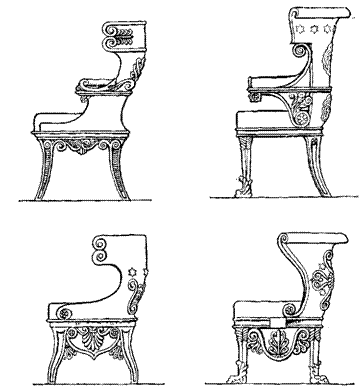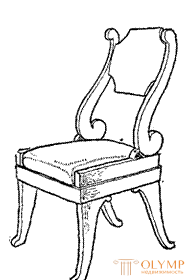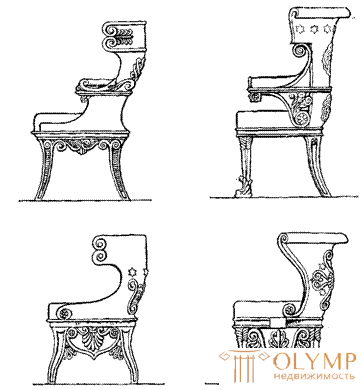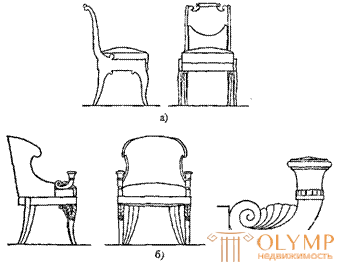
The beginning of the XIX century. was marked by a great upsurge in the development of architecture, urban planning and applied art in connection with the victorious end of the Patriotic War of 1812.
The activities of such architects as M. F. Kazakov, D. Quarenghi, A. D. Zakharov (1761–1811), A. N. Voroi-Khin, closely related to classicism, fall into the first decade of the century. They are accompanied by a constellation of remarkable masters: K.I. Rossi (1775–1849), V.P. Stasov (1769–1848), O.I.Bove (1784–1834), D. Zhilardi (1788–1845), A. G. Grigoriev (1782-1868), who brought new ideas to Russian art.
The first third of the XIX century. includes two stages: the first - before the Patriotic War of 1812, the second - from the moment of the end of this war to the middle of the 30s.
A subtle master of the interior of the early XIX century. was architect A. Voronikhin, author of the magnificent Kazan Cathedral and the Mining Institute in St. Petersburg. He actively worked as a master of applied art, creating a large number of drawings for furniture and furnishings.
After the fire of the palace in Pavlovsk in 1803, Voronikhin re-created a number of interiors, including the “flashlight” room. The small room of the flashlight is divided by an arch into two parts - the main rectangular and lighter, completed with a glazed bay window. The architectural effect is based on the opposition of the shaded and lighted parts of the room. The dividing arch is supported by the caryatids by sculptor V. I. Demuth-Malinovsky (1779–1846). According to Voronikhin’s drawings, furniture and vases were made for the flashlight. For the Greek Hall, the architect made sketches of sofas and armchairs upholstered in trellis.

Fig. 1. Chair according to the drawing by A. N. Voronikhin (beginning of the 19th century)

Fig. 2. Chair design by architect V. P. Stasov (the 20s of the XIX century.)
Architect V. Stasov in 1823-1826. in the Catherine Palace he created a chain of nine rooms, for which, according to his sketches, master A. Tour created furniture: chairs, sofas, tables (fig. 2). KI Rossi, creating the Mikhailovsky Palace (Russian Museum in Leningrad), designed and executed all the interior of the building. Of particular interest is the lobby with widely diverging staircases.
The white-columned hall of the second floor is deployed along its longitudinal axis along the garden facade. It is divided into three parts by Corinthian columns, treated, as well as walls, under white marble. The Belokolonny Hall is the only interior of St. Petersburg of late classicism, which is almost completely preserved to this day. KI Rossi made drawings of furniture (fig. 3) for the palace. Architectural decoration, furnishings and other furnishings were an organic whole. The overall tone of the furniture (white and gold) is connected with the color of the painting of the ceiling and walls. Its wooden parts with succulent carvings are gilded, the upholstery is of blue damask.

Fig. 3. Projects chairs K. I. Rossi
Designing the interior of the Alexandrinsky Theater, Rossi offered two options: the first - a thin metal lattice of the barriers of the boxes with embossed decorative details made of broken copper of various shades, the second - a wooden white parapet and a wooden carved ornamentation covered with gilding. Not in full (only the central lodge) was carried out the second option. The bluish-greenish, light in color overall tone of draperies, complemented by gold stars, abundant gilding of carved details on the general white background of the parapet, painted ceiling in bright colors - all this informed the auditorium of a special ceremonial, decorative and sophistication. In the late 1840s, the blue upholstery was replaced with red.
After the war of 1812, the construction center moved to Moscow. The architects O. Bove, D. Gilardi and A. Grigoriev elevated the culture of interior decoration of buildings to a new level. The Moscow dwelling interior of this pore, having a number of common stylistic features with Petersburg, differed from it in less formality, comfort, and extraordinary plasticity in the elaboration of wall planes and order elements.
When restoring the building of Moscow University (architect MF Kazakov) D. Gilardi creates a unique Assembly Hall in the center of the building. The huge dome of the hall is dissected by means of painting into hexagonal and triangular caissons, covered with grizzail paintings with ornaments and figures (grisaille - French. Grisaille from gris— gray, a type of painting performed in different shades of any one color). The coloring of the finish is based on an unusual combination of colors for the interiors - ocher-yellow and white.
The interiors of Moscow residential houses are unique. The interiors in the mansions of A. Grigoriev are characteristic of the house of Stanitskaya (now the museum of L. N. Tolstoy) and the house of the Khrushchevs (now the museum of A. S. Pushkin). The spatial construction of a suite of rooms with the characteristic use of architectural elements as decorations was decided with great skill. Sewn-in decorative arches of different shapes (semi-circular and sailing) are introduced. In the design of interiors is widely used painting.
The Arkhangelsk estate near Moscow (1810–1830, architect I. D. Zhukov, O. I. Bove, S. P. Melnikov, E. D. Tyurin) is one of the most attractive ensembles in which architecture, sculpture, and painting are harmoniously combined and applied art. The peculiarity of Arkhangelsky is in the confluence of classicism of the end of the 18th and the first third of the 19th centuries, forming a single whole.
Remarkable interiors of the palace and the collection of furniture. The entrance to the halls of the first ceremonial floor opens the lobby, whose walls are dissected by pilasters of the Corinthian order. In the deep niches emphasizing the massiveness of the walls, there are fireplaces serving as pedestals for sculptural groups.
The most luxuriously architecturally decorated central oval hall for receptions, balls and concerts. The eaves are supported by eight paired columns of Corinthian order from yellow artificial marble. Above the columns are arranged choirs, which housed the serf orchestra. Due to the painting of caissons, made in yellow, the impression of the sphericity of the dome is enhanced. The hall is furnished with furniture made of Karelian birch, made by serf masters in Arkhangelsk. Upholstery, fireplace screens, window curtains are made of fabric woven at the Yusupov Kupavin factory. A huge three-tiered chandelier in gilded bronze is made of papier-mâché and levkas on a wire frame.
In the imperial hall, where the portrait gallery of kings, queens and grand dukes was placed, white furniture with gilding was installed in strict forms of classicism of the late 18th century. works of Russian masters.
The palace is typical of the XVIII century. front bedroom. Four Corinthian columns of white artificial marble separate part of the room, forming an alcove, where the carved wooden bed is placed under the canopy of a canopy of blue Lyon silk embroidered with silver.
The music salon is furnished with furniture made of Karelian birch by the serf masters, whose smooth curved lines correspond to the character of the wall painting. Skillfully made applications and embroidery on the upholstery of chairs, sofas and cushions. The interior decoration is complemented by a grand piano of Viennese work from the beginning of the 19th century. and the ladies' writing table of the French work of Jacob style.
For the Russian cabinet furniture of late classicism is characterized by a purely architectural construction of the subject. The volume is divided into pilasters or three-quarter columns, crowned with a cornice. In contrast to French samples, volumes sometimes with cut corners are mostly placed on legs (Fig. 4, a). The ornament is mainly located in the form of palmetto on the corners, which emphasizes the monumentality of forms, reinforcing the impression of the large calm surfaces of the doors and sidewalls of the cabinets. Ornamental compositions are made of laurel and acanthus wreaths, twigs, lire. Ancient motifs become more geometric, less and less resemble a natural vegetative prototype. The ornament of body products is superimposed on the plane of the object, contrasting with it. Pads are most often made of tinted or gilded wood, papier-mâché and ceramics. Bronze is rarely used, usually in St. Petersburg palace ensembles.

Fig. 4. The main types of Russian cabinet furniture of the beginning of the XIX century: a - the secretary of mahogany (about 1825), b — walnut bookcase (1810)
Bookcases are low, glazed doors with trellised bindings (Fig. 4, b). By the 30s, cabinets of all types become more massive, the number of threads increases, it becomes bulky.
The backs of chairs and armchairs are distinguished by a large variety of forms and decorative solutions (Fig. 5). According to the tradition that has been going since the end of the 18th century, the backs of the chairs and armchairs were made, in most cases, through (Fig. 5, a). There are backs rounded outlines supported by side racks, turning into the rear legs. Then the solid backs of the trough-like form extend, organically turning into supports for the elbows, sometimes completed with wood-carved sculpture (Fig. 5, b). The armrests of the chairs are varied in shape: for example, simple horizontal arms, supported by sculpted front pillars — winged fantastic creatures on the same animal paw; volutes on pyramidal tetrahedral legs, volutes that rely on small square squares standing directly on the seat upholstery, etc.

Fig. 6. Types of Russian furniture for seating the beginning of the XIX century: a - mahogany chair (20s); b - mahogany armchair (30s)
Upholstered furniture is covered with leather (morocco), often with bright red chintz with gold stars or striped, sometimes with bouquets of flowers scattered across the field. In the 20s fashionable embroidery wool natural tones. Silk fabrics - plain colors with textured flowers or embroidered with beads. The favorite colors of the upholstery are brown, red, sand (red), green. Such fabrics are used until the 40s of the XIX century.
Tables are round or elongated with high tsargoy. The central pillar is massive and sometimes ornamented. Console adjoined the console in the form of carved sculptures of wood fantastic birds. Often, drawers are embedded in the rye. Console tables with supports connected by arches are common. Further use of the bureau tables.
The furniture was dominated by polished mahogany, Karelian birch, and walnut. Furniture makers of any kind and were able to identify the natural pattern, the texture of wood. The painting of wooden parts in white was also used in combination with gilded carved details. Sometimes the furniture is completely covered with gold leaf. Widely used bronze objects - table clocks, writing instruments. Geometrical and antique motifs prevailed in the fabrics.
Что бы оставить комментарий войдите
Комментарии (0)